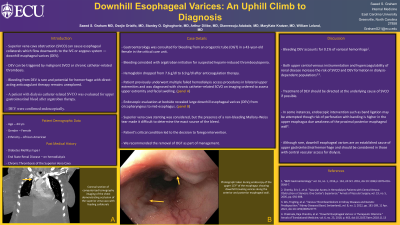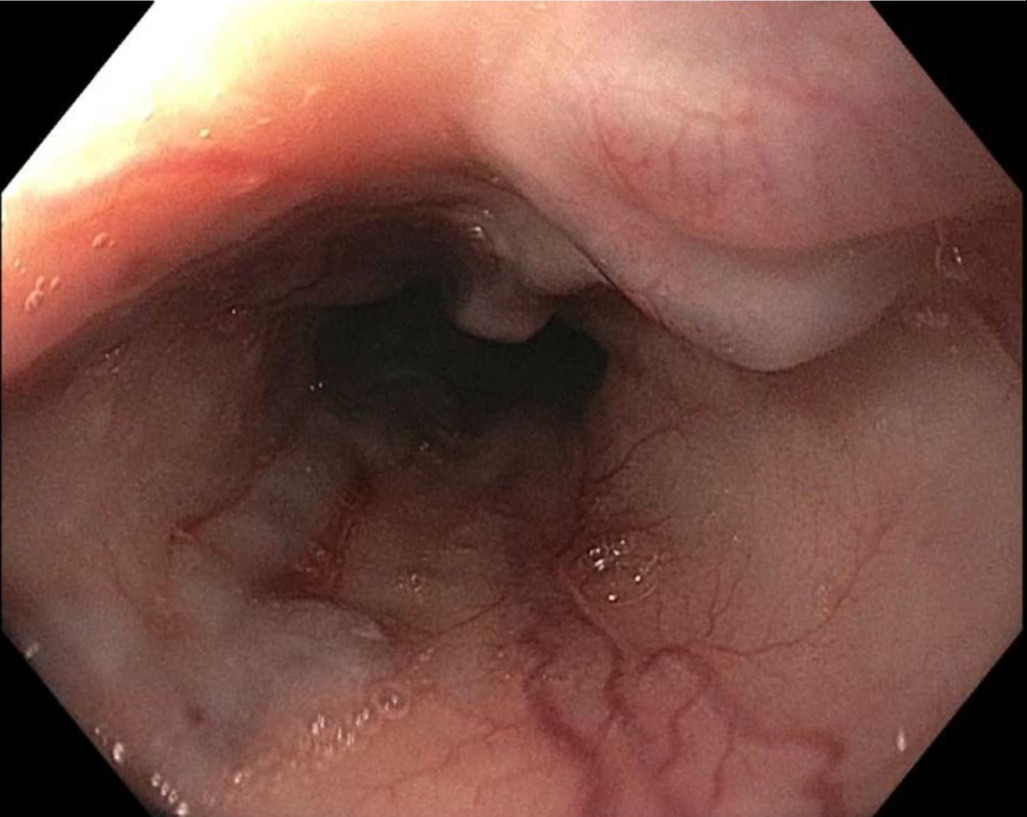Monday Poster Session
Category: Esophagus
P1895 - Downhill Esophageal Varices: An Uphill Climb to Diagnosis
Monday, October 23, 2023
10:30 AM - 4:15 PM PT
Location: Exhibit Hall

Has Audio
.jpg)
Saeed Graham, MD
East Carolina University Brody School of Medicine
Greenville, NC
Presenting Author(s)
Saeed Graham, MD1, Osejie Oriaifo, MD1, Arthur Dilibe, MD1, Stanley O. Oghoghorie, MD2, Olanrewaju Adabale, MD1, MaryKate Kratzer, MD1, William Leland, MD1
1East Carolina University Brody School of Medicine, Greenville, NC; 2ECU Health Medical Center, Greenville, NC
Introduction: Superior vena cava obstruction (SVCO) of any cause results in the formation of esophageal venous collaterals with a “downhill” direction of flow towards the azygos or inferior vena cava, coined — downhill esophageal varices (DEV). Though malignant SVCO is most common, chronic catheter associated thrombosis has become increasingly relevant in the dialysis era. Bleeding from DEV is extremely rare and their risk of hemorrhage with direct oral anticoagulant (DOAC) therapy remains unexplored. The following details a patient with dialysis catheter related SVCO, evaluated for upper gastrointestinal bleed after argatroban therapy. DEV were confirmed endoscopically.
Case Description/Methods: Gastroenterology was consulted for evaluation of bleeding noted from the orogastric tube (OGT) of a 43-year-old female in the critical care unit. The bleed coincided with the initiation of argatroban the day prior for suspected heparin induced thrombocytopenia. Labs showed a hemoglobin of 6.9 g/dl from 7.6 g/dl before DOAC therapy. Pertinent history included type 1 diabetes, with diabetic nephropathy resulting in end stage renal disease. Half a decade before presentation, she was found to have chronic thrombosis of the superior vena cava, likely related to dialysis catheter insertion. Her current admission was for management of diabetic ketoacidosis and septic shock. She was endoscopically evaluated at bedside under conscious sedation. Soon after intubation of the esophagus, large DEV were noted extending from cricopharyngeus to mid esophagus. Superior vena cava stenting was considered however an identified non-bleeding Mallory-Weiss tear confounded the culprit source lesion. Due to critical illness, intervention was foregone. She was transfused 1 unit of packed red blood cells and removal of the OGT was recommended.
Discussion: DOACs are known to increase the risk of variceal bleeding in those with typical portal hypertension associated esophageal varices. Patients with DEV from device related SVCO are a unique population. DOAC related esophageal variceal bleed risk in these patients is unknown. Although some uncertainty remained regarding bleeding site, this case highlights the importance of exercising caution in patients with DEV on DOAC therapy.

Disclosures:
Saeed Graham, MD1, Osejie Oriaifo, MD1, Arthur Dilibe, MD1, Stanley O. Oghoghorie, MD2, Olanrewaju Adabale, MD1, MaryKate Kratzer, MD1, William Leland, MD1. P1895 - Downhill Esophageal Varices: An Uphill Climb to Diagnosis, ACG 2023 Annual Scientific Meeting Abstracts. Vancouver, BC, Canada: American College of Gastroenterology.
1East Carolina University Brody School of Medicine, Greenville, NC; 2ECU Health Medical Center, Greenville, NC
Introduction: Superior vena cava obstruction (SVCO) of any cause results in the formation of esophageal venous collaterals with a “downhill” direction of flow towards the azygos or inferior vena cava, coined — downhill esophageal varices (DEV). Though malignant SVCO is most common, chronic catheter associated thrombosis has become increasingly relevant in the dialysis era. Bleeding from DEV is extremely rare and their risk of hemorrhage with direct oral anticoagulant (DOAC) therapy remains unexplored. The following details a patient with dialysis catheter related SVCO, evaluated for upper gastrointestinal bleed after argatroban therapy. DEV were confirmed endoscopically.
Case Description/Methods: Gastroenterology was consulted for evaluation of bleeding noted from the orogastric tube (OGT) of a 43-year-old female in the critical care unit. The bleed coincided with the initiation of argatroban the day prior for suspected heparin induced thrombocytopenia. Labs showed a hemoglobin of 6.9 g/dl from 7.6 g/dl before DOAC therapy. Pertinent history included type 1 diabetes, with diabetic nephropathy resulting in end stage renal disease. Half a decade before presentation, she was found to have chronic thrombosis of the superior vena cava, likely related to dialysis catheter insertion. Her current admission was for management of diabetic ketoacidosis and septic shock. She was endoscopically evaluated at bedside under conscious sedation. Soon after intubation of the esophagus, large DEV were noted extending from cricopharyngeus to mid esophagus. Superior vena cava stenting was considered however an identified non-bleeding Mallory-Weiss tear confounded the culprit source lesion. Due to critical illness, intervention was foregone. She was transfused 1 unit of packed red blood cells and removal of the OGT was recommended.
Discussion: DOACs are known to increase the risk of variceal bleeding in those with typical portal hypertension associated esophageal varices. Patients with DEV from device related SVCO are a unique population. DOAC related esophageal variceal bleed risk in these patients is unknown. Although some uncertainty remained regarding bleeding site, this case highlights the importance of exercising caution in patients with DEV on DOAC therapy.

Figure: Endoscopic image of upper one-third of the esophagus with large downhill varices extending from cricopharyngeus to mid esophagus.
Disclosures:
Saeed Graham indicated no relevant financial relationships.
Osejie Oriaifo indicated no relevant financial relationships.
Arthur Dilibe indicated no relevant financial relationships.
Stanley Oghoghorie indicated no relevant financial relationships.
Olanrewaju Adabale indicated no relevant financial relationships.
MaryKate Kratzer indicated no relevant financial relationships.
William Leland indicated no relevant financial relationships.
Saeed Graham, MD1, Osejie Oriaifo, MD1, Arthur Dilibe, MD1, Stanley O. Oghoghorie, MD2, Olanrewaju Adabale, MD1, MaryKate Kratzer, MD1, William Leland, MD1. P1895 - Downhill Esophageal Varices: An Uphill Climb to Diagnosis, ACG 2023 Annual Scientific Meeting Abstracts. Vancouver, BC, Canada: American College of Gastroenterology.
